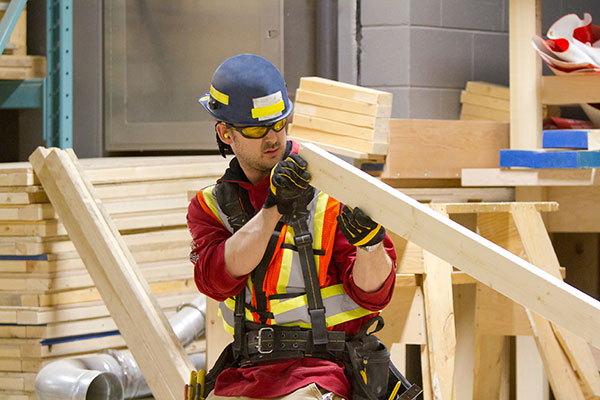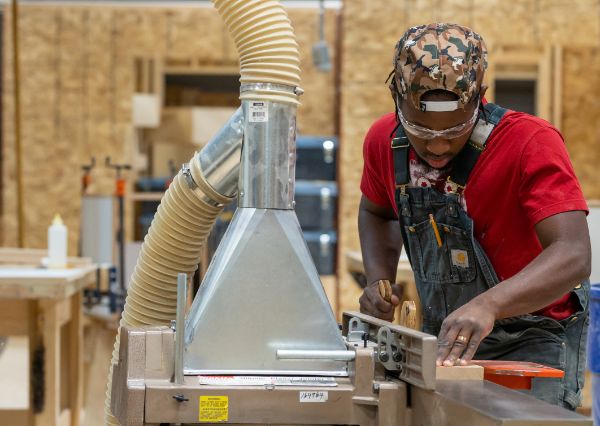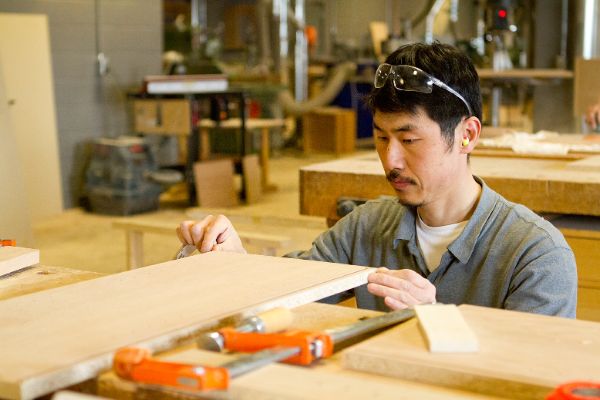On this page:
Overview
Carpenters are essential in many construction areas, including residential, commercial, industrial, and maintenance projects. Work ranges from residential framing to commercial tower builds.
This program is designed to provide you with the foundational skills and knowledge required to become a proficient carpenter. It aligns with the curriculum of a first-year carpentry apprenticeship, enabling you to work on job sites confidently.
As a student, you will learn:
- how to read and interpret blueprints, essential for planning and executing carpentry projects
- how to identify and handle suitable materials for different construction tasks, understand their properties
- to proficiently use manual and power carpentry tools and equipment
- to precisely measure and mark materials for cutting and assembly
- cutting and shaping techniques for different building materials
- joinery and assembly techniques such as nailing, screwing, and using adhesives, ensuring structural integrity
- safety practices and the proper use of personal protective equipment (PPE) to minimize risks and ensure a safe working environment.
You'll also have networking opportunities to meet prospective employers, learn how to write a resume, and participate in a job interview.
As a graduate, you will be well prepared to join the workforce as an apprentice carpenter and challenge the first-year apprenticeship exam.
With further experience and training, you may advance into roles such as journeyman carpenter, construction foreman, project manager, or even running your own carpentry business.
Carpenters tend to be objective, methodical and innovative.
You need:
- manual dexterity
- good balance for working on scaffolding
- math skills to quickly and accurately solve problems
- the ability to follow and communicate written instructions
- the ability to work as a team.
You should enjoy creating things with your hands, working with wood, and mastering your craft.
This program aligns with the first period of Alberta Apprenticeship and Industry Training's (AIT) Carpenter curriculum.
Graduates are eligible to register as apprentices and challenge the first-period exam.
Once you pass the exam and complete the necessary training hours with an employer, you may register for SAIT's Carpenter apprenticeship program beginning in period two.
Upon successful completion of the program, you'll receive a SAIT Pre-Employment Carpenter certificate.
Careers and opportunities
Each year, SAIT conducts a survey between February and April to determine the employment rate, salary and satisfaction of our newest SAIT alumni.
![]() 100% graduate employment rate
100% graduate employment rate
![]() $44,900 average starting salary
$44,900 average starting salary
Find out more about our graduate employment statistics >
Our graduates may work in the following occupations. Some careers require additional experience and education.

Career planning support
Unsure which career path is for you? Here are some recommended career planning resources to help you decide your future.
You can also head to Alberta alis for lots of information about careers in Alberta, including quizzes and labour market information to help you narrow down a path.
Finally, you can take our online career finder quiz, which can help narrow your options based on your current skills and interests.
Courses
The Pre-Employment Carpenter program requires 12 credits (four courses) to complete.
| Course | Credits |
|---|---|
|
This course covers topics on basics, orthographic drawings, pictorial drawings and sketching, drawing standards, drawing interpretation principles. Equivalents:
|
1.5 |
|
This course on carpentry construction theory covers topics on worksite safety, fire prevention and control, ladders and scaffolds, WHMIS, rigging, solid wood products and wood joinery, manufactured construction products, fasteners, adhesives and sealants, introduction to concrete, preliminary building operations, construction equipment, foundation supports, concrete flatwork, conventional concrete foundations, and alternate foundations systems. Equivalents:
|
3 |
|
This course on construction laboratory covers topics on the use of hand tools, portable power tools, stationary power tools, explosive actuated tools, pneumatics and fuel powered tools, building layouts, construct footings, concrete flatwork, foundation systems, floor frame and support. Equivalents:
|
6 |
|
Mathematics for carpentry covers topics on basic math concepts: calculate perimeters, centreline perimeters, area, volumes, ratio and proportion, mechanical advantage and percentage, estimate foundation forms and concrete, and estimate residential floor systems. Equivalents:
|
1.5 |
Progression
You must attain a PGPA and/or a CGPA of 2.0 or better each semester and pass the prerequisite courses to progress through the program.
To qualify for graduation, you must pass all courses, attain a CGPA of 2.0 or better and complete course requirements within the prescribed timelines.
Admission requirements
Applicants educated in Canada
Applicants must demonstrate English language proficiency and completion of the following courses or equivalents:
- English Language Arts 10-1 or English Language Arts 10-2, and
- Math 10C or Math 10-3.
SAIT accepts high school course equivalents for admission for applicants educated outside Alberta.
All applicants who were educated outside of Canada must demonstrate English language proficiency and provide proof they meet the program admission requirements outlined above with an international document assessment. Find accepted educational documents and assessment options.
SAIT may also accept courses completed at certain international post-secondary institutions.

Academic Upgrading
Missing an admission requirement for this program? Upgrade your prior education to help you receive admission into one of SAIT's career programs.

English language proficiency
All applicants must demonstrate English language proficiency prior to admission, including students educated in Canada.
Transfer agreements
At SAIT, we evaluate post-secondary credit you have previously earned and apply it to your SAIT credential. Explore our formal transfer agreements available for this program.
We can evaluate your prior education, even if we don't have a formal agreement in place.
Submit a transfer credit application
There are no formal transfer agreements currently in place for this program.
Transfer options for graduates
Build on the knowledge you’ve learned at SAIT. The opportunity to advance your education at an accredited post-secondary institution may be available.
🔗 Visit Transfer Alberta search tool for all transfer agreements in Alberta (including UCalgary, MRU and BVC).
If there are transfer agreements with other institutions outside of Alberta, nationally or internationally, they will be listed below.
Alberta Apprenticeship and Industry Training
- Program name
- Apprenticeship Pathway
- Available credits:
- n/a
Upon successful completion of this program, you'll be eligible to register as an apprentice and challenge Alberta Apprenticeship and Industry Training’s (AIT) first-period examination for the trade.
Available intakes
Winter 2025
Start dates:
- Domestic students: Closed
-
-
Application deadline:
-
Fall 2025
Start dates:
- Domestic students: Waitlisted
-
-
Application deadline: June 30, 2025
-
Winter 2026
Start dates:
- Domestic students: Open
-
-
Application deadline: Oct. 24, 2025
-
- Domestic students: Open
-
-
Application deadline: Oct. 24, 2025
-
Costs
2025/26 tuition and fees
The following estimated costs are effective as of July 1, 2025.
The estimated total cost of tuition and fees is based on completing the program within 12 weeks. Following a modified schedule will impact the fees you pay per semester and may alter final costs.
Domestic students
**Students in this program do not qualify for the UPass or health and dental plans, nor do they pay Saitsa fees.
Books and supplies are approximately $1,000 - $1,500 per full-time year.
This is a bring-your-own-device program with a standard computer hardware and software requirement. See the specific requirements on our computers and laptops page.
Find your booklist on the SAIT Bookstore's website. The booklist will be available closer to the program start date.
Can't find your program or course? The bookstore didn't receive a textbook list. Contact your program directly to determine if they're still refining course details or if you're in luck; no textbook purchase is required this term.
Required personal protective equipment (PPE)
- CSA steel toe boots
- Safety glasses
- Hearing protection - will be provided but students may choose to bring their own.
Required equipment or tools
- Metric/imperial tape measure (min. 16')
- Marking pencil

Financial aid
Paying for your education may feel overwhelming, but we have resources and programs that can help, including information about payment options, student loans, grants and scholarships.
This program is eligible for Canada Alberta Job Grant funding.
Application process
Ready to apply?
Follow our step-by-step guide to submitting a successful application.
Communication during admission
Email is the primary source of communication during the selection process. Ensure your personal email account is managed appropriately to receive our emails, files and communications. We recommend you add the construction.advising@sait.ca domain to your safe senders' list or you risk missing critical email messages.

Begin your application
Apply now using the online application portal.
Ensure you have a valid Visa or Mastercard to pay the non-refundable application fee of $120 for domestic applicants.
Information sessions
Prepare for a strong start in your chosen program or get the details you need to decide your future path.
Our expert staff and faculty are ready to answer your questions and provide information about the following:
- What sets SAIT apart
- An introduction to the program and area of study
- Admission requirements
- Future career paths
- Information on the earning potential and graduate employment rates.
Contact us
School of Construction Advising
-
Phone - 403.284.8367
Subscribe for updates
Your journey starts here! Sign up to get important updates on:
- Business and leadership programs
- Application information
- Relevant news and events

Oki, Âba wathtech, Danit'ada, Tawnshi, Hello.
SAIT is located on the traditional territories of the Niitsitapi (Blackfoot) and the people of Treaty 7 which includes the Siksika, the Piikani, the Kainai, the Tsuut’ina and the Îyârhe Nakoda of Bearspaw, Chiniki and Goodstoney.
We are situated in an area the Blackfoot tribes traditionally called Moh’kinsstis, where the Bow River meets the Elbow River. We now call it the city of Calgary, which is also home to the Métis Nation of Alberta.




